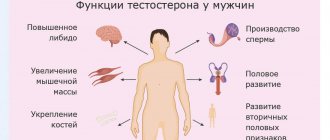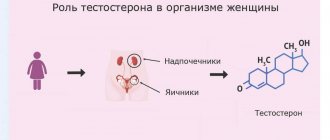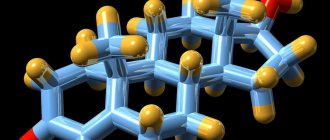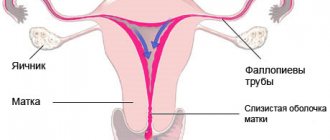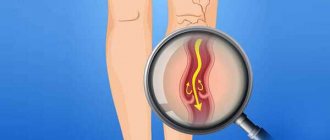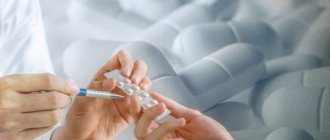What is the role of testosterone in men?
The content of the article
Impaired testosterone secretion is associated with the development of a condition medically called hypogonadism. Hypogonadism is a dysfunction of the gonads in the male testicles, due to which they are not able to provide the body with the necessary amount of hormones. Testosterone, produced primarily in the testicles, plays an important role in the development and maintenance of many male physical characteristics.
For example, this hormone is responsible for:
- sexual desire;
- sperm production;
- maintaining proper muscle mass and muscle strength;
- distribution of fat and bone mass.
There are primary and secondary hypogonadism. With primary hypogonadism, the functioning of the testicles themselves is impaired. Secondary hypogonadism occurs when problems are localized in the brain structures - the hypothalamus or pituitary gland, which control the functioning of the gonads.
Hypogonadism
As men age, testosterone levels gradually decline, and this is a natural phenomenon.
Minimize stress
Under severe, prolonged stress, the body produces cortisol, which actually blocks the effect of testosterone. This is how our body works, and there is nothing you can do about it.
In the modern world of permanent depression and chronic stress (and, consequently, with constantly elevated cortisol), the effect of testosterone is blocked too often and a lot, which we absolutely do not want.
Photo Credit: US Army Korea (Historical Image Archive) via Compfight
On Lifehacker you will find many articles about effective methods for relieving stress and combating depression. Perhaps meditation or yoga will help you.
Low testosterone levels - symptoms
Low testosterone levels cause a variety of symptoms, including decreased sexual desire and vitality, as well as erectile dysfunction. Additionally, men with low testosterone levels may experience decreased testicular density, breast enlargement, and loss of muscle mass. Body hair growth occurs more slowly, but voice and penis size usually remains the same.
Hypogonadism increases the likelihood of developing osteoporosis and osteoporotic fractures. Low testosterone levels may also cause adverse mental changes. In this case, the behavior of a man is similar to that of a woman during menopause. The patient notes a feeling of constant fatigue, mood swings, irritability and even hot flashes.
Osteoporosis
Constant fatigue
Limit or completely eliminate sugar from your diet
As blood sugar levels rise, testosterone begins to decline. There is an assumption that insulin reduces testosterone levels. In any case, excessive consumption of sweets leads to obesity, so this advice is somehow useful.
According to research, the average US resident consumes 12 teaspoons of sugar per day. That is, he will eat 2 tons of sugar in his life.
Fast carbohydrates are found not only in sweet foods. Pasta, bakery products (pizza too, yes) - all this should be consumed very carefully.
How is low testosterone diagnosed?
If the urologist suspects low testosterone based on symptoms and physical examination, he or she will refer the patient for a testosterone test. This is the only way to confirm the diagnosis.
Most testosterone is bound to sex hormone binding protein and albumin. In young men, unbound testosterone (called free testosterone) is only about 2%. Due to the fact that measuring free testosterone is not accurate, it is preferable to test total testosterone levels (bound and free).
Testosterone test
Testosterone levels are best measured in the morning because the hormone follows a daily rhythm and reaches its highest value around 8:00 am.
Tests are also performed for other testosterone-stimulating hormones - LH (luteinizing hormone) and FSH (follicle-stimulating hormone). With their help, you can determine the primary or secondary cause of low testosterone levels.
Power training
In addition to intense training, there is another type of training that significantly stimulates testosterone production - strength training. As long as you do strength training at the right intensity, your testosterone levels will increase.
The key principle of strength training: less repetitions, more weight, more compound exercises. Such exercises require adequate preparation and practice, so do not rush to lie down under a 100 kg barbell.
Another option that allows you to get the desired effect with less weight is to slow down the negative phase of the exercise or slow down the execution of the entire exercise, that is, both the negative and positive phases.
Low testosterone - treatment
Is there a need to treat low testosterone? Most studies of testosterone treatment indicate improvements in libido and sexual function in men with hypogonadism or low levels of male hormones. Researchers note that the therapy increases interest in sexual relations and increases the number of spontaneous erections. However, testosterone therapy may not improve erectile dysfunction if the underlying causes are not hormonal imbalance.
In addition to its effects on the sexual sphere, testosterone treatment improves mood, relieves symptoms of depression, fatigue and confusion. Research also shows a positive effect on bone density.
Over the past decade, interest in testosterone hormone therapy has increased dramatically. Various forms of this substance are available: short and long-term injections, oral preparations, patches and gels.
Testosterone pills are the most widely available, but urologists and endocrinologists usually do not recommend taking them. In this form, testosterone is quickly metabolized and cannot reach the required level in the blood. In addition, the use of testosterone in this form can cause dangerous side effects - liver dysfunction, including benign and malignant tumors.
Testosterone therapy
How do testosterone gels and patches work? Testosterone patches, although more expensive, are a convenient alternative to injections due to ease of use and maintenance of normal testosterone levels.
There are two methods of delivering testosterone through the skin: patches that are attached to the skin or in the scrotal area, and gels that are rubbed into the skin. Both options provide a constant supply of testosterone, which is absorbed through the skin and gradually released into the blood. But these options will only be effective at a certain level of testosterone, so you must first get tested and only then select a treatment method.
Menu for increasing testosterone
To obtain the daily requirement of vitamins that increase testosterone, you must include in the menu: 1. Salads from fresh vegetables and herbs (cabbage, cucumbers, carrots, beets, parsley, leeks, dill, basil, peppers, others). 2. Lean meat (baked, boiled). 3. Fermented milk products (kefir, cottage cheese, cheeses). 4. Buckwheat and rice porridge. 5. Nuts and seeds. 6. Fruits and berries (oranges, apples, bananas, currants, beaks, etc.). 7. Decoctions (rose hips, parsley root, celery). 8. Tea with ginger.
To increase testosterone in the blood, it is recommended to take vitamin complexes. A study in the field of andrology has proven that taking medications containing vitamin D, B vitamins, ascorbic acid and other beneficial compounds stimulates testosterone secretion by 30-40%.
Testosterone treatment - what tests to do?
Patients receiving testosterone therapy are advised to have their hormone levels checked every 3-4 months during the first year of treatment. The first follow-up visit to the doctor is required in a month. The urologist will evaluate the effect of therapy and determine whether the dose of testosterone needs to be reduced or increased.
The optimal time of day to measure testosterone levels depends on the form of administration. The highest concentration of testosterone in the blood serum is observed approximately 4-8 hours after administration of the drug. When using the gel, testosterone levels are maintained at a relatively constant level, so testing time is not critical.
Men using testosterone therapy should perform the following tests (before and periodically during follow-up):
- PSA analysis;
- Ultrasound of the prostate gland;
- Rectal examination of the prostate gland - to monitor the effect of therapy on the prostate gland;
- Hematocrit and hemoglobin test - to measure the number of red blood cells.
Zinc
Eating foods that contain zinc can increase the production of male androgens. These include: • meat (the most Zn is in beef, veal, poultry), offal (beef, chicken heart, liver, kidneys, tongue); • seafood (mussels, squid, cuttlefish, oysters, etc.); • nuts (record holders for Zn content – pecans, pine nuts, Brazil nuts, walnuts, peanuts); • seeds (sunflower, pumpkin, sesame); • dried fruits (dried apricots, raisins, prunes); • vegetables (all types of cabbage, carrots, radishes, beets, celery root); • fruits (citrus fruits, apples, plums, bananas, pears, others).
The following substances impair the absorption of Zn and the production of testosterone: • oxalic acid; • calcium compounds; • iron; • selenium; • tannins.
When there is a deficiency of Zn in the body, and as a result, low testosterone, it is recommended to limit the consumption of dairy products, strong black tea, red wine, and sorrel. The following help improve the absorption of this microelement: • vitamin B6; • citric acid derivatives; • picolinic acid.
You should include in your diet a variety of beans, fresh fruits, herbs, as well as nutritional supplements - brewer's yeast (a source of B vitamins). An adult male aged 19-50 years should receive at least 15 mg of zinc per day. Magnesium is a component of many enzymes necessary for the absorption of vitamins that stimulate testosterone production. It acts as a vasodilator, therefore it reduces blood pressure, promotes relaxation and liberation during sexual intercourse. Sources of magnesium include fresh greens, nuts, whole grain cereals, brewer's yeast, and kelp (sea kale).
Testosterone in the female body
The fair sex has a certain amount of masculinity, but their bodies produce less testosterone. The hypothalamus, adrenal glands, and ovaries are responsible for production; they take on about 50% of the production of the required amount. The rest is formed as a result of the processing of other hormones of steroid origin. Under its influence, the following occurs in the female body:
- muscle formation;
- follicle maturation;
- regulation of fertility and libido;
- maintaining bone density;
- estrogen synthesis;
- metabolic water-salt, lipid processes.
Testosterone is important for a lady; without it you can’t talk about health and well-being. The norm is considered to be 0.290-1.67 nmol/l at the age of 18 to 50 years and 0.101-1.42 nmol/l for 51 years or more. Those at risk are those who:
- diet regularly;
- smoke and drink alcohol;
- rarely spend time outdoors;
- suffer from physical inactivity or exercise too intensely;
- have an irregular sex life;
- take oral contraceptives, drugs for fungal infections, anticonvulsants.
With its deficiency, infertility, diabetes, dry hair, skin, sweating, decreased memory, concentration, osteoporosis, cardiovascular pathologies, premature menopause, oncology of the mammary glands and uterus are often diagnosed. Therefore, knowing how to increase testosterone in women is very useful.
BCAAs
In addition to the protein shakes discussed in the second point as part of intermittent fasting, a man who is actively involved in sports will benefit from increasing the amount of BCAA amino acids he receives. These essential amino acids for humans can be found in regular foods (for example, there is a lot of leucine in cheese), as well as in special supplements.
Don't be negative about sports nutrition. In fact, high-quality supplements are an almost pure product, without impurities or any nasties.
When sufficiently supplied to the body, amino acids help create the right anabolic environment. This is exactly what we need.
Why does the amount of male hormones in a woman increase?
In a woman's body, androgens are produced in the ovaries and adrenal glands. Hormonal imbalance can occur both due to improper functioning of these organs and for other reasons:
- Adrenogenital syndrome (AGS) . This is an inherited disease caused by a mutation in a specific gene. With AGS, the adrenal glands produce significantly more androgens.
- Hereditary diseases of the adrenal glands . The body increases the production of glucocorticoid hormones, which, with cortisol deficiency, are converted into androgens.
- Tumors of the ovaries and adrenal glands . In neoplasms, androgens are synthesized directly by tumor cells.
- Polycystic ovary syndrome (PCOS) . In this case, due to the cysts, the ovaries produce a lot of testosterone and cannot produce enough estrogen.
- Metabolic syndrome . Due to increased insulin levels, ovarian tissue cannot produce enough estrogen, resulting in increased androgen levels. The polycystic ovary syndrome mentioned above often develops due to metabolic syndrome.
- Taking certain medications (for example, anabolic steroids act similarly to testosterone in the body).
